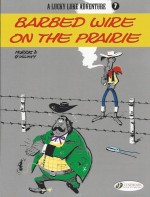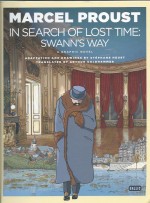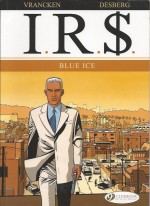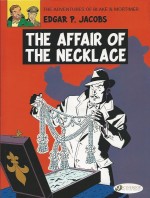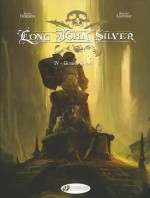
By Xavier Dorison & Mathieu Lauffray, translated by Jerome Saincantin (Cinebook) ISBN: 978-1-84918-175-4
British and European comics have always been far more comfortable with period-piece strips than our American cousins and much more imaginative when reinterpreting classical fiction for jaded comicbook audiences. The happy combination of familiar exoticism, past lives and world-changing events blended with drama, action and, most frequently, broad comedy has resulted in a uniquely narrative art form suited to beguiling readers of all ages and tastes.
Our Franco-Belgian associates in particular have made an astonishing success out of repackaging days-gone-by – generally in comedic form – but this particularly enchanting older-readers yarn forgoes broad belly-laughs whilst extending the adventures of literature’s greatest rogue into a particularly engaging realm of globe-girdling thriller with one hell of a twist.
Robert Louis Stevenson’s Treasure Island was originally serialised from 1881-1882 in Young Folks magazine as Treasure Island or, the mutiny of the Hispaniola, as pseudonymous penned by “Captain George Northâ€.
It was collected and published as a novel in May 1883 and has not been out of print since. A landmark of world storytelling, Treasure Island has been dramatised too many times to count and adapted into all forms of art. Most significantly, the book created a metafictional megastar – albeit at best an anti-hero – as immortal as King Arthur, Robin Hood, Sherlock Holmes, Tarzan or Superman. Almost everything the public “knows†about pirates devolves from the book and its unforgettable, show-stealing one-legged antagonist…
Writer Xavier Dorison was born in Paris in 1970 and graduated business school before moving into storytelling. He works as an author, film writer, lecturer and movie script doctor. His comics works include West, Sanctuary and The Third Testament and in 2006 he began the award-winning Long John Silver in conjunction with preferred collaborator Mathieu (Prophet) Lauffray, with this last volume released in Europe in 2013.
Lauffray is also Parisian; born in 1970. He spends his days illustrating, drawing comics, crafting games and concept designing for movies. His art has graced international items as varied as Dark Horse’s Star Wars franchise, games like Alone in the Dark, the album Lyrics Verdun, February 21, 1916 – December 18, 1916, Tarzan and much more…
Their collaborative exploration of the piratical prince’s later years is a foray into far more mature arenas set decades after the affair of the Hispaniola and ranges far and wide: from foggy, oppressive England to the vast, brooding inner recesses of the Amazon and into the darker deeps beyond
What Has Gone Before: in 1785 treasure-hunting Lord Byron Hastings found the lost bastion of Guiana-Capac but needed further funds to exploit this fabulous City of Gold.
In England, his profligate and wanton wife Lady Vivian had been enjoying herself too much and was with child by a lecherous neighbour. With a baby in her belly and a husband three years gone, she was considering having Byron declared dead and undertaking a hasty remarriage…
Suddenly shattering those plans her despised brother-in-law turned up with an aged, garish tribesman named Moxtechica bearing both message and map from her long-lost husband. Prudish and cruel, Royal Naval officer Edward Hastings gleefully told the despicable scheming strumpet his brother had succeeded and demanded she sell everything – including all the treasured family possessions, manor house and lands she had brought to the marriage – to finance his return…
Byron named Edward sole Proxy and the martinet delighted in giving high-born trollop Vivian her marching orders. He even urged her to confine herself to a convent and save them all further shame and disgrace…
The Lady considered numerous retaliatory tactics before settling upon the most bold, dangerous and potentially rewarding. After announcing to the stunned Edward that she would accompany him to the Americas and reunite with her beloved husband, the fallen noblewoman sought out a certain doctor to help care of her problem…
Dr. Livesay was a decent, god-fearing soul who led a quiet, prosperous life ever since his adventures on Flint’s Island. However, it was not just her condition which brought Vivian to the physician’s door, but also persistent tales of a former acquaintance; a formidable, peg-legged rogue with a reputation for making life’s difficulties disappear…
Against his better judgement, Livesay capitulated to Vivian’s urgings and introduced her to retired sea-cook John Silver. Amidst the (alleged) ex-pirate’s inner circle of scary-looking confederates she spun the story of the Spaniard Pizarro’s discovery of a City of Gold and how, centuries later, her husband had reclaimed it.
She wanted to travel there with capable men and make those riches her own, but needed Silver and his associates to infiltrate Edward’s crew, seize the ship he’d chartered and complete the voyage under her command…
Unable to convince Vivian to desist or Silver to reject her offer, Livesay reluctantly joined them in vain hopes that he could keep the debased woman from mortal harm. Nobody was aware Silver concealed a debilitating, soon-to-be-fatal affliction as the rascal orchestrated his own hiring and thereafter packed the Neptune with suitable scoundrels – but only after compelling Lady Vivian to sign a sacrosanct Pirate’s Contract.
With each schemer believing their own plans were proceeding satisfactorily, the ship sailed, but at the last moment Silver suffered a major setback when rival rogue Paris inveigled his way onto the crew…
As the tense voyage progressed, Silver’s men, Paris’ contingent and even Hastings’ innocent hires all slowly succumbed to the sea cook’s glib tongue and bombastic tales of the Red Brotherhood.
Only Hastings’ lieutenants Dantzig and Van Horn had any inkling of the battle of wills below decks, but even that shaky détente shattered when Lady Vivian’s maid Elsie was murdered. Painfully aware that everybody aboard was gripped by gold-fever, Hastings had been ruling with a rod of iron and full naval discipline. Settling upon Jack O’Kief (Paris’ protégé, but beloved by Silver) as responsible for her death, Hastings had the boy brutally flogged.
A prolonged battle of wills followed, pushing the crew to the edge of mutiny. Hastings delayed final landfall off the tantalisingly close South American coastline and strained tempers exploded just as a colossal storm pushed the Neptune inexorably towards its foregone destination. Inevitable mutiny erupted, resulting in appalling bloodshed and a red-handed settling of many scores…
Literally above it all, old shaman Moxtechica rode out both tempests, patiently waiting to see what dawn might bring…
In the ghastly aftermath of the twin maelstroms the becalmed and battered Neptune drifted idly off-shore and survivors reeled aimlessly on her decks until Silver’s ferocious tongue-lashing brought them to life.
Now completely in charge, the old pirate makes Dantzig (the only trained pilot/navigator left) second-in-command, despite the Navy Man swearing he’ll see them all hang one day…
Boldly sailing the ship straight into the cliffs, Silver and Dantzig navigated a barely discernible channel through the stony walls and brought the Neptune into a sedate, beguiling tributary of the Amazon. With time taken to repair and recover, however, the men soon resort to their old ways. Dead are buried, some old scores settled and Jasper, a new rival to Silver’s authority, began to assert himself. Seeing the way things were going, Vivian stepped in, employing wiles and cunning…
Seducing the entire crew with her story of Emperor Viracocha and his City of Gold, she tells of how her husband claimed it and won them over by revealing how they would take it from him…
The wary mariners impatiently and so-slowly sailed up the vast river in an epic voyage through labyrinthine courses and jungle backwaters. Each time they stalled, Moxtechica was there, silently divining their route to Guiana-Capac.
This sparked growing suspicion in Vivian. Her brutal, impatient husband was never given to trusting or inspiring loyalty – even in other Englishmen – and she harboured grave doubts over the shaman’s true motives…
Those same thoughts plagued Silver and his wily shipmate Olaf as the river grew perilously shallow, especially after the voyagers discovered the foundered, rotting hulk of Hastings’ ship The Nimrod in the shallows abutting a vast overgrown, jungle-smothered city…
As Silver readied the depleted contingent to begin searching the ruins, Vivian surprised him by requesting to be put aboard Nimrod. Perhaps her husband’s ship held answers to the many questions vexing her. As she scanned his grimy journal, aboard Neptune nobody really cared that Moxtechica was missing… but they should have…
This epic conclusion commences as Vivian is taken and reunited with her husband. Lord Byron is a much altered man with a new overarching passion…
Meanwhile, at the gates of the city Silver and his small scouting party – which includes Doctor Livesay – are confronted by the gloating shaman before being set upon by gigantic iguanas. Forced to plunge deep into the sinister metropolis to save themselves, their hasty explorations uncover a map crafted by the Conquistadors. It does not depict where gold is stored but rather where the Christian warriors set huge stores of gunpowder in an attempt to destroy the infernal god-forsaken citadel…
Silver is undaunted: he came for treasure and will not be thwarted, but as the Englishmen continue their search they discover a procession of robed natives ascending to a temple and cautiously follow.
Vivian is still reeling at the changes to her husband and the disclosures he fervently shares. He evangelically recounts the story of his own voyage and reveals that he came not for gold but in search of an ancient god.
He was successful…
This was also what the Conquistadores came for, but they failed in their quest to destroy the profane entity and now its long-foretold coming is imminent. Its latest high priest then reveals it is currently feeding one-by-one on the captured crew of the Neptune, but what it really craves and requires is the baby in Vivian’s belly…
The appalled Lady reels, realising at last that the entire venture has been a Byzantine ploy to bring her to the city where the God will use the results of her sins to finally come to Earth…
Equally aghast are Silver and his party: they have stumbled upon a colossal chamber in time to see Olaf beguiled and sacrificed. Helpless to save him they swear terrible vengeance. Vivian is of the same mind as she drives a great sword through the body of her smug, uncomprehending and astounded husband…
Too furious even to plot, Silver goes on a rampage and whilst slaughtering priest-natives discovers the rest of his crew. Leaving his companions to rouse the drugged or ensorcelled shipmates and get them back to the Neptune, Silver storms on. Followed by Livesay the rogue eventually finds an inner chamber rigged with more barrels of gunpowder. It’s also packed floor to ceiling with glittering gold…
As the seamen make a valiant last stand against the enraged and innumerable warriors of Guiana-Capac, Vivian stumbles upon Silver and Livesay moments before Moxtechica find them. Knowing the value of her child to the pagan maniacs she holds her own life hostage until the pirate and doctor can get away…
As the outnumbered buccaneers sell their lives dearly across the city, Vivian is taken to the sacrificial chamber for the consummation of centuries of arcane anticipation, but inveterate villain Silver finds himself acting completely against his nature, aligning with the doctor in a most uncharacteristic manner to foil the hellish natives, frustrate a god and still claim the treasure his entire life has been dedicated to winning…
And as a man-made apocalypse descends upon the infernal city, the slightest whim of fate and steadfast determination of the unlikeliest of heroes saves a small fraction of the doomed company to tell the tale…
Suspenseful, eerily compelling, spectacularly powerful and magnificently realised, this final exploit of Long John Silver sets the seal on a modern masterpiece of adventure fiction worthy of Stevenson’s immortal adventure (and perhaps even the works of Clark Ashton Smith or H.P. Lovecraft). They might even convince a few more folks to actually read the originals.
This is unmissable stuff which could only be improved upon by bundling all four albums into one single treasure-trove volume…
© Dargaud, Paris, 2013 by Dorison & Lauffray. All rights reserved. English translation © 2013 Cinebook Ltd.



